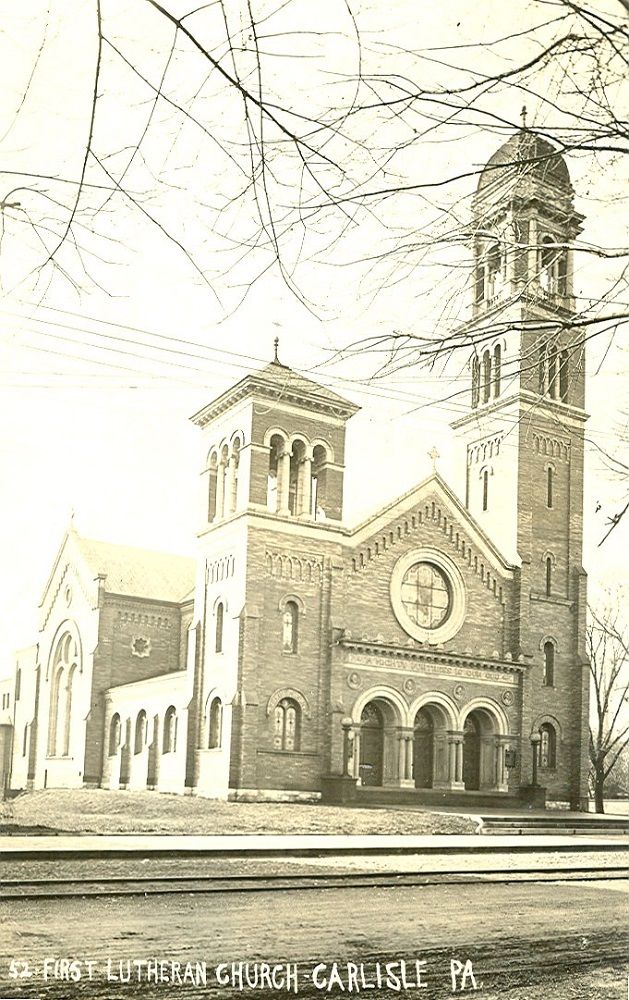The Carlisle Borough Charter claims that the First Lutheran Church began about 1765 when the German immigrants of Reformed and Lutheran church background worshiped together in a union church on South Hanover Street near South Street.1 In 1807, the church divided and the Lutherans built a church at the corner of Louther Street southward on Bedford to Mulberry Alley.2 The pastor at this time was Frederick deSanno. During these early years, the pastors also served other congregations in the Carlisle vicinity.
Finances inevitably affected buildings and ministry. In 1810, the German churches raised money via a lottery. In the 1840s, the Lutherans instituted pew rents to insure a consistent cash flow for maintenance. When fire destroyed the church building in 1851, other churches in Carlisle generously offered financial aid. The Second Presbyterian Church as well made their facility available for Lutheran worship.3
The initial language used by the church was German. At the time when the church groups divided in 1807, English was making inroads in the community. Nonetheless, sermons were given in German and an English-speaking pastor was regarded as “strange.” Benjamin Keller, hired as pastor in 1816, was the first English speaking pastor. During his tenure, the church vestry ruled that English services would alternate with German.4
Not long after this date, the Lutherans built their own school house and maintained a parochial school in Carlisle until the Common School act eventually provided free schools. During this period, English became more commonly used and the need for English sermons increased.5
When Jacob Fry came as pastor in 1854, the church had called a pastor who could not speak German. As a result, the remnant of the congregation who wanted to hear sermons in German departed with the good wishes of the mother body and built its own church at the corner of South Bedford and East Pomfret Streets. The congregation that remained was now known as the English Lutheran Church.6
In 1865, the beginnings of St. Paul’s Lutheran Church in Carlisle emerged from a mission endeavor by the Lutherans of First Church. The new congregation used the German Lutheran Church building until finally constructing its own edifice at Louther and West Streets. The German group which had split from First Church merged with the St. Paul mission.7
Fire struck Carlisle in 1851 and destroyed the English Lutheran Church. Although in debt for repairs to the now ruined structure, the church members moved quickly to rebuild (and to purchase fire insurance).8
Church archives assert that on Sunday, June 28, 1863, when Confederate troops occupied Carlisle, four churches held services: The Lutheran Church, the Episcopal, the Reformed, and Second Presbyterian. The record claims that attendance was slight but a number of Confederate officers were present.9
Henry Barr Wile was called to pastor the church in 1886. Under his leadership, the church planned a new structure. Dr. Wile’s untimely death in 1899 placed the burden of guiding the new construction on the next pastor, George Diffenderfer. The new building, which stands at the south east corner of East High Street and South Bedford Street, was dedicated in 1901.10
The years since have seen changes to the First Lutheran Church structure with remodeling and additions. In 1931, the worship space was renovated. By 1967, the church had completed the addition of a two-story education wing. The project included clearing unused land and providing parking spaces. In 2002, renovation of the Narthex and Sanctuary were done and handicap accessibility was provided. During the twentieth century, the melodeon of 1865 gave way to a series of organs and more recently the refurbishment and rebuilding of the present instrument.11
Throughout its history, the First Lutheran Church has served the Carlisle community well. Sunday School began as early as 1826. Women’s Missionary Societies prospered in the 20th century. And its music ministry continues to benefit both the church and Cumberland County residents. The “Fine Arts at First” series of guest artists in this 21st century makes available some of the best musical talent of the area.
Two quotes capture the essence of this church. About the Sunday School: “The success of such an organization cannot be measured in dollars and cents, nor yet by the numbers of pupils in attendance, nor yet by any other physical standards. They can be measured only in bettered lives and bettered living.”12 And about the ministry of the church: “The Past is but prologue, yet we continue in the traditions of our forebears in this historic old church.”13


